Guitar Legends: Keith Richards – why the human riff is a true guitar innovator
If there’s one guitar player who encapsulates the very sound of his band, it’s the Rolling Stones’ Keith Richards. His playing is idiosyncratic, loose, hard to copy… and the stuff of legend.
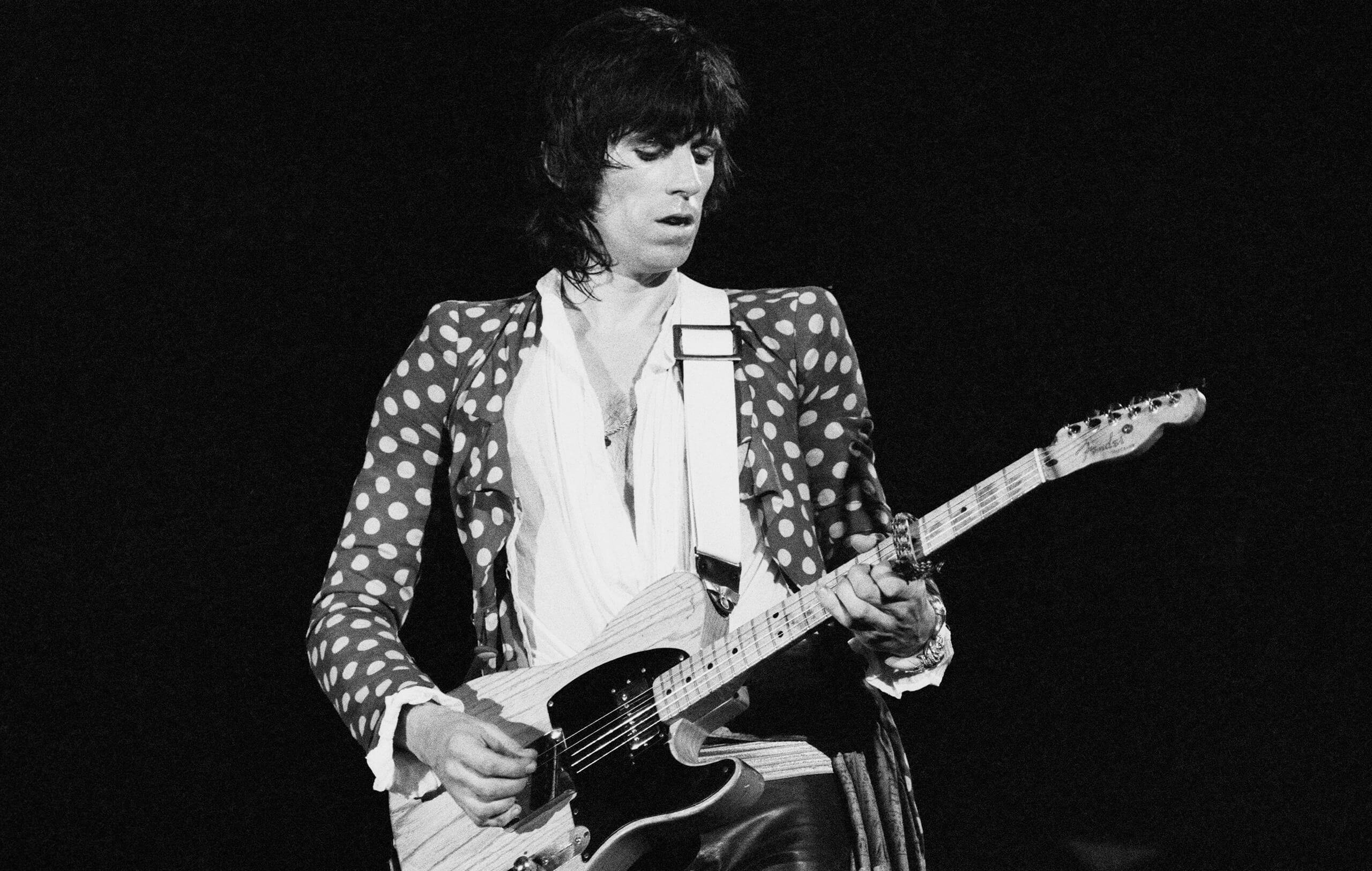
Image: Evening Standard / Hulton Archives / Getty Images
The constant knife carrying. The supposed blood transfusions. The falling asleep onstage. The aggressive defence of his shepherd’s pie… Among all the colourful myths and legends of the life of Keith Richards, it’s sometime easy to forget he’s actually a very good guitar player… and something of an innovator. While it’s true that the Rolling Stones wouldn’t exist without any of Mick Jagger, Charlie Watts or Richards, one only has to listen to the human riff’s solo albums to realise it is he that is shot to the core with the Stones’ DNA. Mick Jagger’s solo records? It would be most polite to say they are just something he does when the band are inactive.
Given that the Rolling Stones will mark 60 years as a band in 2022, it’s no surprise that Richards’ style has undergone changes. Some may argue they haven’t even released a must-have album for the last 40 years of that time, and that’s one reason there are twice the number of live or compilation Stones album as there are original studio projects.
But there is enough in the Stones’ “imperial period” of studio albums to mark Keith Richards – 77 years old/young/‘worn in’ – as one of guitar’s true legends, unique stylists, and a player it’s deceptively difficult to copy…

“It’s all about the roll…”
From his boyhood obsession with Elvis‘ guitar player Scotty Moore, to his teenage years of learning nearly every Chuck Berry solo, to his more (back then) esoteric obsessions with Muddy Waters, Hubert Sumlin and Jimmy Reed, Richards is a man of relatively simple tastes. His style is rooted in old-time R&B and blues (not blues rock), doesn’t care for heavy rock or metal or the titular roles of ‘lead’ and ‘rhythm’ guitar player, nor the latest innovations in guitar technology. As he once succinctly put it, “Fuck the rock, it’s all about the roll, baby…”
The one notably ‘musicianly’ upheaval Keith has ever made is his noted five-string open G tuning, but he kinda nicked that idea off Ry Cooder. Richards, nevertheless, plays it like no other. But even so, his playing can almost be divided into pre- and post-open G styles, with a side-dish of his endearing faith in the power of acoustic guitar. Let’s skim across an unrivalled 60 years of rockin’…and rollin’.
In his own words
“The acoustic guitar is the most important thing for a guitar player to start with… You want to be a guitar player, you have to have your grounding. An astronaut doesn’t start in space, somebody’s got to build a rocket.”
“Rock ’n’ roll is, in one way, a highly structured music played in a very unstructured way.”
“The only things Mick and I disagree about is the band, the music and what we do.”
“Rock ’n’ roll. Music for the neck downwards.”
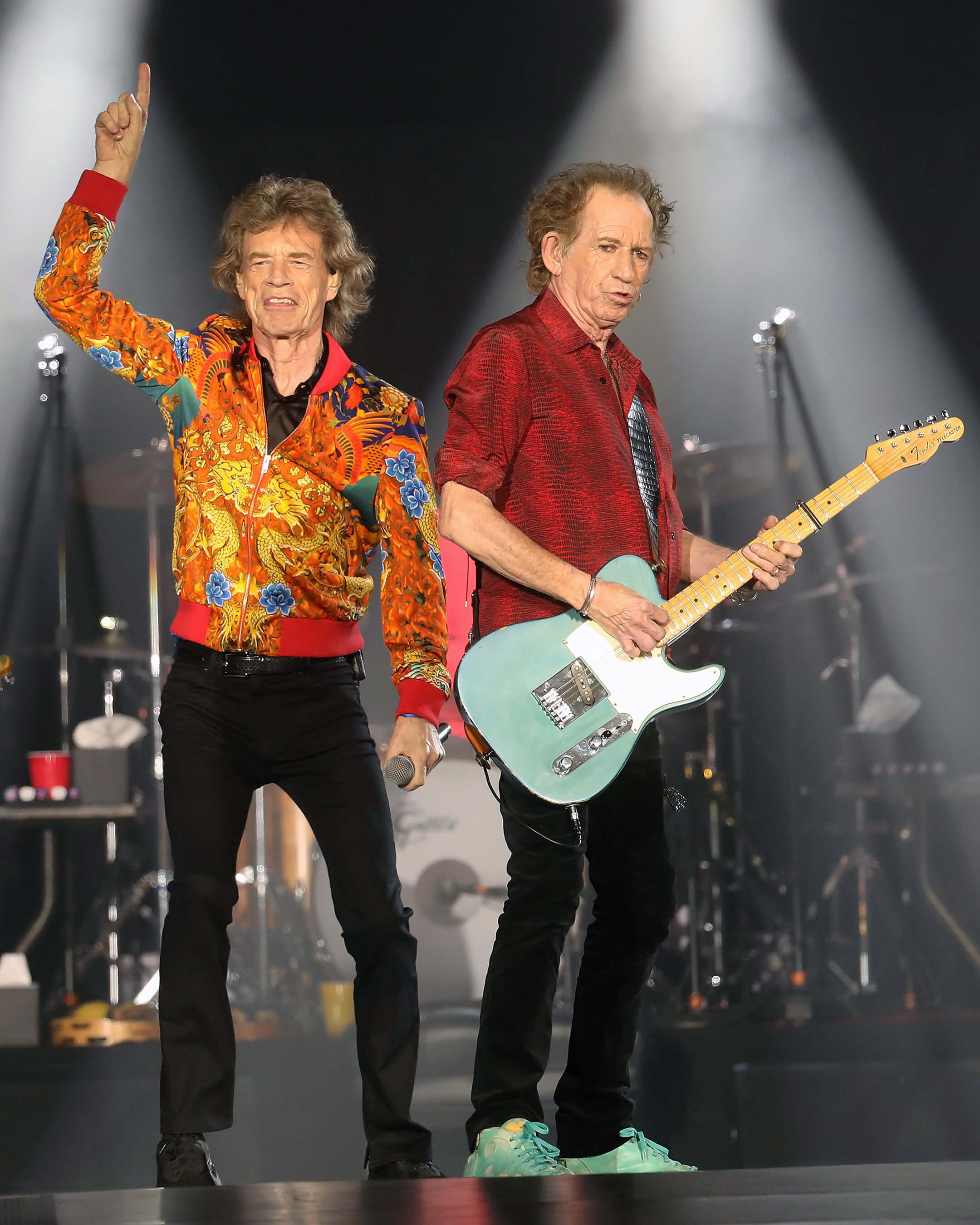
Early Stones tones
Before the money started to roll in, Richards relied on his Harmony Meteor H70, acquired in January 1963. He’d debated whether to buy a Harmony or a Hawk model, but went with the former due to its two pickups (see Life.) The H70 had a maple back and sides, bolt-on maple neck, and two DeArmond Golden Tone pickups. It was finished in 2-tone sunburst, and Keith’s was likely made in 1960 or 1961.
But soon, Richards was diving deep into his axe habit – he reportedly owns or has owned 3,000 guitars in his long career. A famed Richards guitar from early TV shows in particular was his 1962 Epiphone Casino, likely bought just before the Stones started their first US tour. The Stones’ American adventures allowed him to acquire all manner of fine guitars rarely seen in the UK and, unlike The Beatles, he wasn’t tied to any endorsement deals.
“I’m pretty sure that Epiphone was on It’s All Over Now and probably some of the earlier ones from England,” he later recalled. “I used it for a good while, mainly because I had it. It was a nice guitar, because Epiphone was a branch of Gibson. [Back them Epiphones were built in the same Kalamazoo factory – Ed.] It was a great guitar for studio work and in clubs. But once we got into theatres and bigger gigs, I found the feedback and howl of those Epiphones was uncontrollable and I started to go for solid-bodies, like the Les Paul.”
What Richards simply calls ‘The Les Paul’ is another iconic Keith guitar. He got his retro-fitted Bigsby Burst around 1964, and was likely the first any of the big UK stars of the 60s to play one. It had come from Selmer’s Music shop in London, and was previously played by John Bowen of pop hopefuls Mike Dean & The Kinsmen.
Rolling Stones Gear’s author Andy Babiuk tells Guitar.com, “It’s got a really colourful past. Most good guitars do, or at least have a good story attached to them. I’m sure it was Keith’s first Les Paul, seen on many live shows. The funny thing is, Ian Stewart sold it when the Stones were doing the Their Satanic Majesties Request sessions…” Note that some dispute this, and say the sale actually actually occurred during the Let It Bleed Sessions. Some reckon Eric Clapton had borrowed it for Cream’s show at the Windsor Jazz & Blues Festival of 1966 (though EC has never mentioned it), and that Jimmy Page used it on at least one mid-60s recording sessions. Both stories are unclear. But it did eventually end up with Mick Taylor.
“I spoke to Mick about it,” said Babiuk. “His Les Paul got ripped-off when he was with John Mayall. Mick needed a Les Paul, that was the tone he wanted. Via a mutual friend, he found out that Keith would sell guitars, but Ian Stewart would arrange the sale. Mick went to Olympic Studios. The Stones were in the next room. Mick simply bought the guitar and left. That was way before Mick Taylor was in The Rolling Stones.
“There are great pictures of Mick Taylor playing that guitar with John Mayall, just in clubs. And later, of course, Mick joins the Stones. [Indeed, Taylor plays it on his debut with The Stones in Hyde Park in July 1969 – Ed.] Apparently, Keith didn’t even realise it had been sold. Keith also uses it again in 1969, like it had never been sold. That story, to me, is really funny.
“Then, it got stolen in the Stones heist in France,” Babiuk continues, referring to the theft of Stones gear from their Nellcôte base in the early 70s. “Keith’s Flying V got stolen, a host of guitars. But it eventually resurfaced. “In the Rolling Stones Gear book we managed to the get the guitar, took it apart, and did a really nice set of pictures. And we got a previously unpublished photo of Keith in the studio with that Les Paul where you can really see the wood grain. It’s pretty cool.
“Bob Bownes was the Stones’ ’64-’65 US tour manager. He had a 35mm camera, he took about 3000 pictures of The Stones. He had photos of The Stones of the Chess Sessions, for example. And The Stones at their RCA sessions. Really cool. That Les Paul is a really cool guitar, to me.”
It’s pretty certain the Burst was Keith’s guitar on Little Red Rooster, Time Is On My Side, The Last Time, Get Off My Cloud, and Let’s Spend the Night Together. Between this Burst and his Epiphone Casino, a lot of early hits were covered. But by the time Stones appeared on The Ed Sullivan Show (aired on 11 September 11 1966), Keith had a black Les Paul Custom and appeared to have moved on from the Burst. This ties in with the notion that its ‘keeper’ from thereon was Ian Stewart… until returning in the ownership of Mick Taylor.
Later still, it ended up in the hands of Bernie Marsden. “This was about 1977,” Bernie told Guitar.com back in 2013. “It wouldn’t stay in tune so I took the Bigsby off. It was no big deal, this wasn’t the stuff of magazine covers back then. When I got it, I was assured it was Keith Richards’ old Les Paul, one of the most iconic.
“But with all respect to Keith, it wasn’t a patch on The Beast [Bernie’s own fabled 59 Burst]. It was good, but not close to playing and sounding like my Beast…” A few more owners down the line, and the ‘KeithBurst’ Les Paul is now in the hands of a private collector.
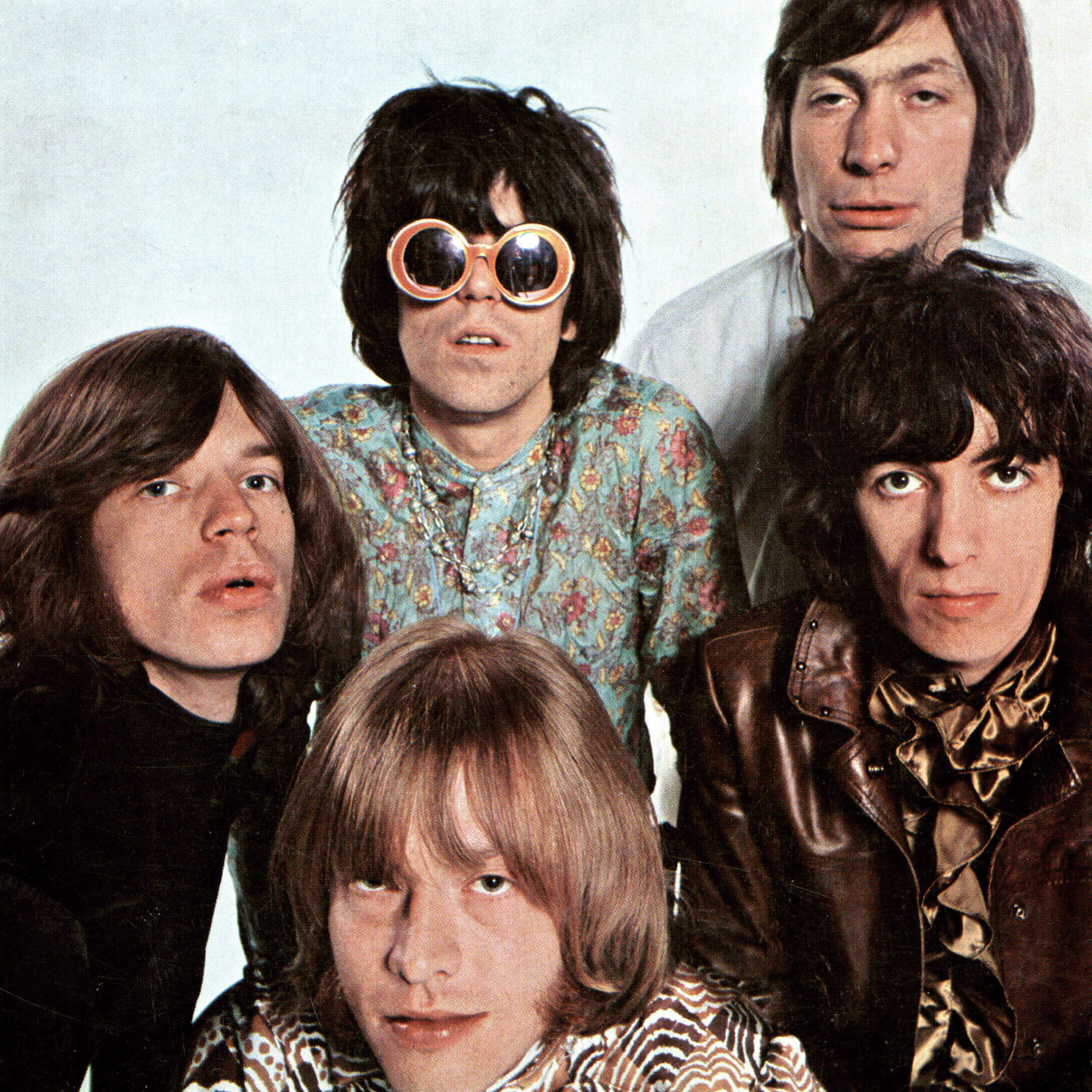
Fuzzed out
Despite Richards saying technology is not important, one of hist most defining riffs did rely on an innovation. The riff for (I Can’t Get No) Satisfaction came to Richards (he says) in a dream while on the Stones’ second US tour, recording the now-iconic riff on his Philips cassette player before falling back to sleep. On that cassette player, there’s a recording of around two minutes of guitar strumming before the music stops, a pick hits the floor and “then me snoring for the next 40 minutes,” he explained.
When it came to the studio, he at first he thought of the Satisfaction riff as a parping horn arrangement but there was no time or money for that. “Whatever it was, it was the first (fuzztone box) Gibson made,” he said in memoir Life. “I was screaming for more distortion: This riff’s really gotta hang hard and long, and we burnt the amps up and turned the shit up, and it still wasn’t right.
“And then Ian Stewart went around the corner to Eli Wallach’s Music City or something and came around with a distortion box. ‘Try this’. It was as off-hand as that. It was just from nowhere. I never got into the thing after that, either. It had a very limited use, but it was just the right time for that song.” For the record, the stomp was a Maestro FZ-1A Fuzz-Tone.
Richards has said a few times he didn’t particularly care for … Satisfaction and that Otis Redding’s horn-led cover was closer to how he originally imagined it. But, given the Stones’ Satisfaction was “the record of the summer of 65… I’m not arguing.”
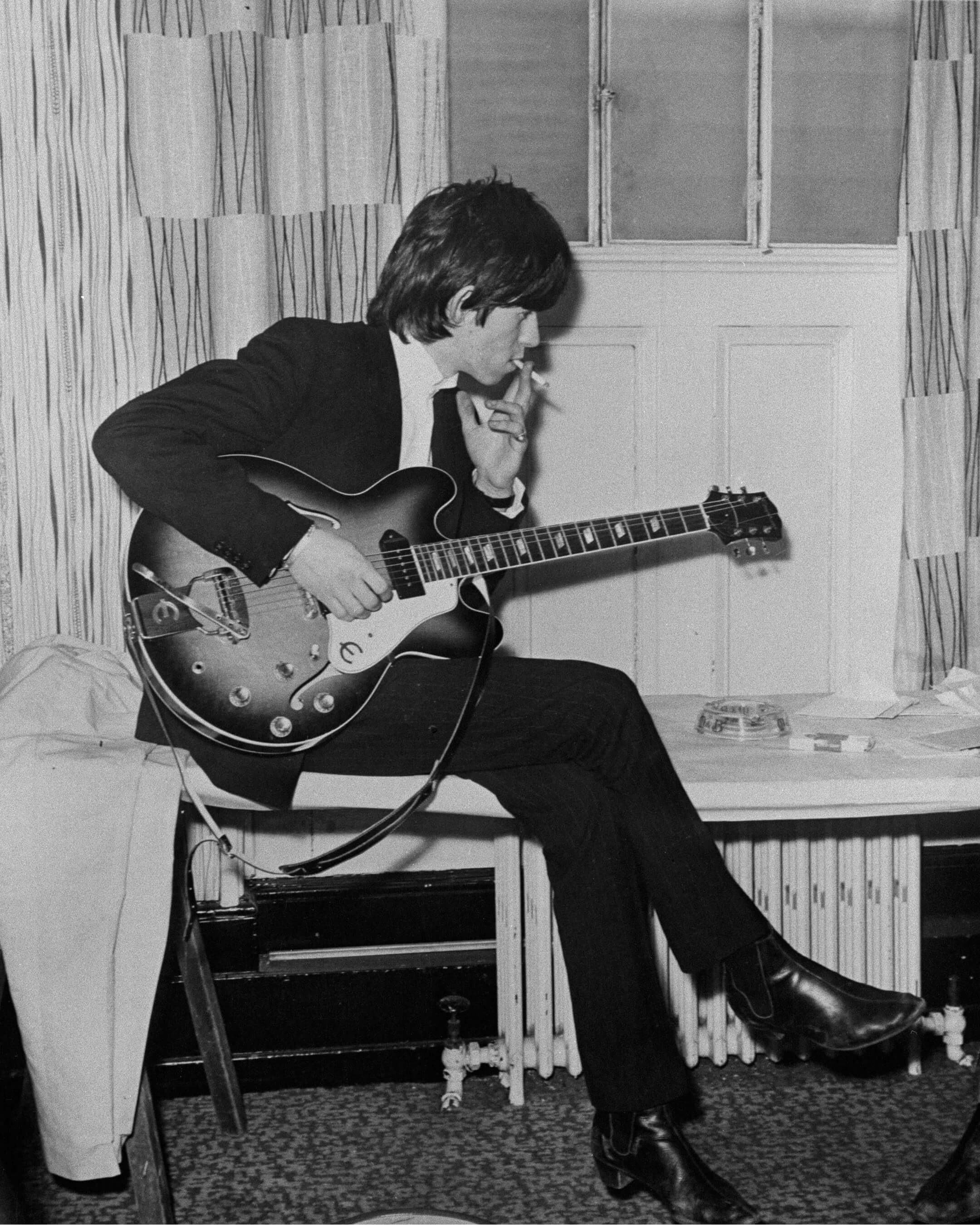
Weaving in acoustics
Another part of Richards’ style in the mid-60s was blending in acoustic and electric guitars. No big deal these days, but quite forward thinking for its time. Early on in the Stones, he had an affordable Harmony H-1270 12-string. This was used on As Tears Go By, Not Fade Away, Tell Me and other songs, and it was a regular until mid 1964 (It was sold in 2004 for $33,460 at Christie’s.)
But by 1966, he’d acquired his first Gibson Hummingbird… and his approach got bolder. He famously used acoustics as “electric guitars” on Jumpin’ Jack Flash and Street Fighting Man (both 1968).
For …Flash he recalled, “I used a Gibson Hummingbird acoustic tuned to open D, 6-string. Open D or open E, which is the same thing – same intervals – but it would be slackened down some for D. Then there was a capo on it, to get that really tight sound. And there was another guitar over the top of that, but tuned to Nashville tuning. I learned that from somebody in George Jones’ band in San Antonio in 1964. The high-strung guitar was an acoustic, too. Both acoustics were put through a Philips cassette recorder. Just jam the mic right in the guitar and play it back through an extension speaker.”
Street Fighting Man used much the same approach, with the distortion of Richards’ cassette recorder providing the drive. “There’s one six-string and one five-string acoustic. They’re both in open tunings, but then there’s a lot of capo work. There are lots of layers of guitars on Street Fighting Man, so it’s difficult to say what you’re hearing on there. ’Cause I tried eight different guitars, and which ones were used in the final version I couldn’t say.” Richards also played bass on both tracks.
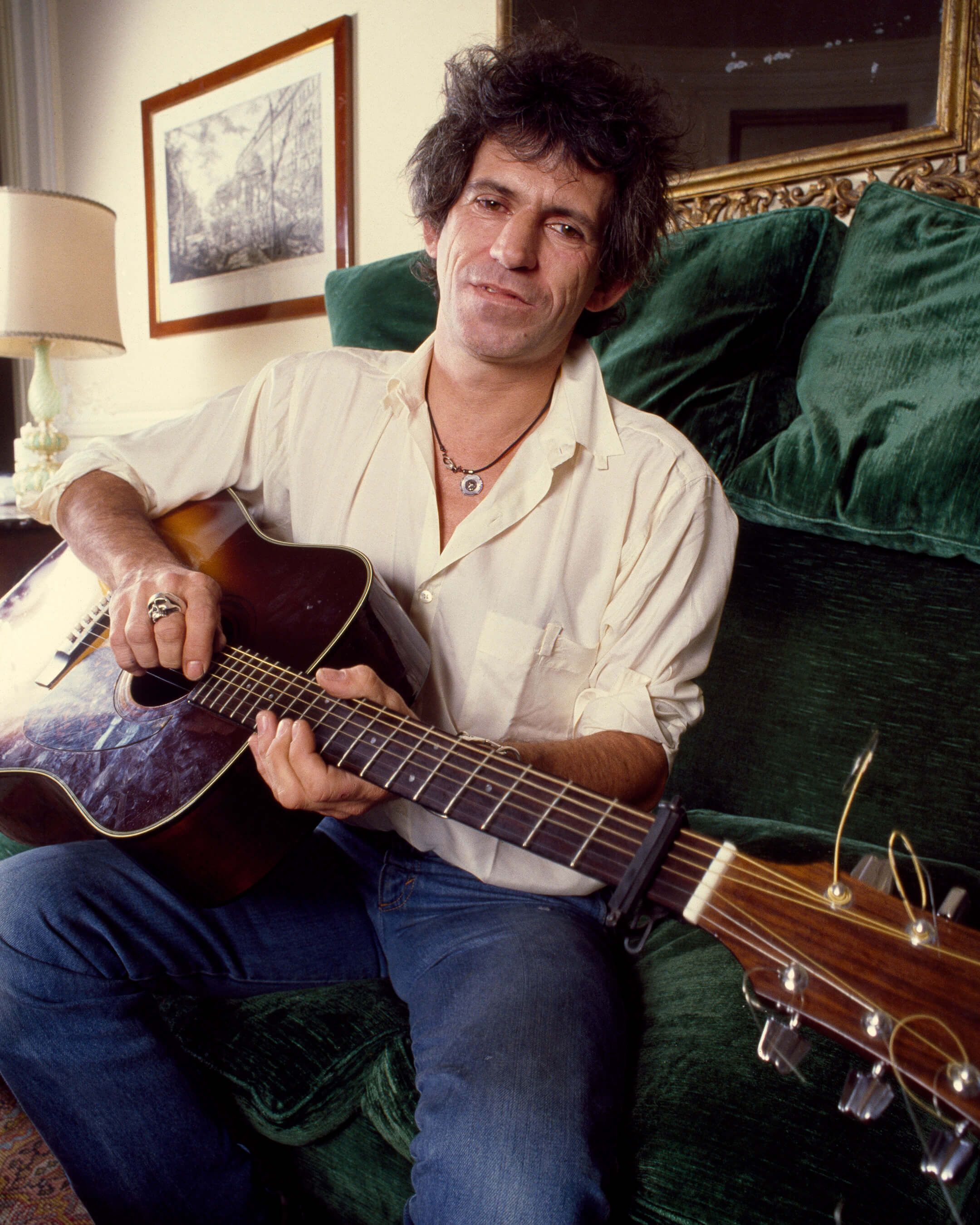
New tunings and sounds
After Brian Jones’ death, the Stones recruited Mick Taylor and he was key on some of their most-acclaimed albums – Sticky Fingers (1971), Exile On Main St (1972) and Goat’s Head Soup (1973) still stand proud today as indelible classics of rock music, with many loving Taylor’s invigoration of the band. As an alumnus of John Mayall’s Blues Breakers (he played with Mayall after Eric Clapton and the late Peter Green), Taylor was a scorching addition to the Stones; fire poured atop of Richards’ oily riffology. And, of course, he arrived with Keith’s Gibson Les Paul Burst… not that Richards necessarily realised.
But while the likes of Slash credit Mick Taylor’s contributions to the Stones as a key influence, Richards later conceded he wasn’t comfortable all the time with their partnership. “It was much harder to get a Rolling Stones sound with Mick Taylor,” Richards reckoned. “It was much more lead and rhythm, one way or the other. As fabulous as he is as a lead guitarist, he wasn’t as great as a rhythm player, so we ended up taking roles.”
The key thing is, Taylor’s tenure in the band coincided with Richards’ growing handprint of his own rhythm riffing, much in Open G, that it was a huge success anyway. Stones classics from this period – Brown Sugar, All Down The Line, Can’t You Hear Me Knocking, Bitch, Rocks Off, and many more – were so reliant on Richards’ riffs, one might claim it didn’t really matter who was on ‘lead’ guitar.
Richards’ road to his specific open G style was a meandering one. “In that period between 66 and Beggars Banquet, I started getting into blues tunings, Fred McDowell, 12-string and slide shit. But still in D and E,” he told Guitar.com.
But when Ry Cooder was hanging around – the slide maestro came in for the Sister Morphine session, eventually released on 1971’s Sticky Fingers – he showed Richards the tuning he would make his own. “I met Ry in 1968, when he was hanging around with Taj Mahal and Jesse Ed Davis. There were people like Clarence White around, too, some good guitar players. So we’d all pick stuff up from each other. Ry was using open G for slide, I saw him and thought, ‘that’s a really nice tuning. It restricts you so much’. Five strings, three notes, two fingers… one asshole!”
Even if the original music was sometimes Jagger’s own – and it quite often was – the imprint of Richards’ open G riffing defined the Stones from herein.
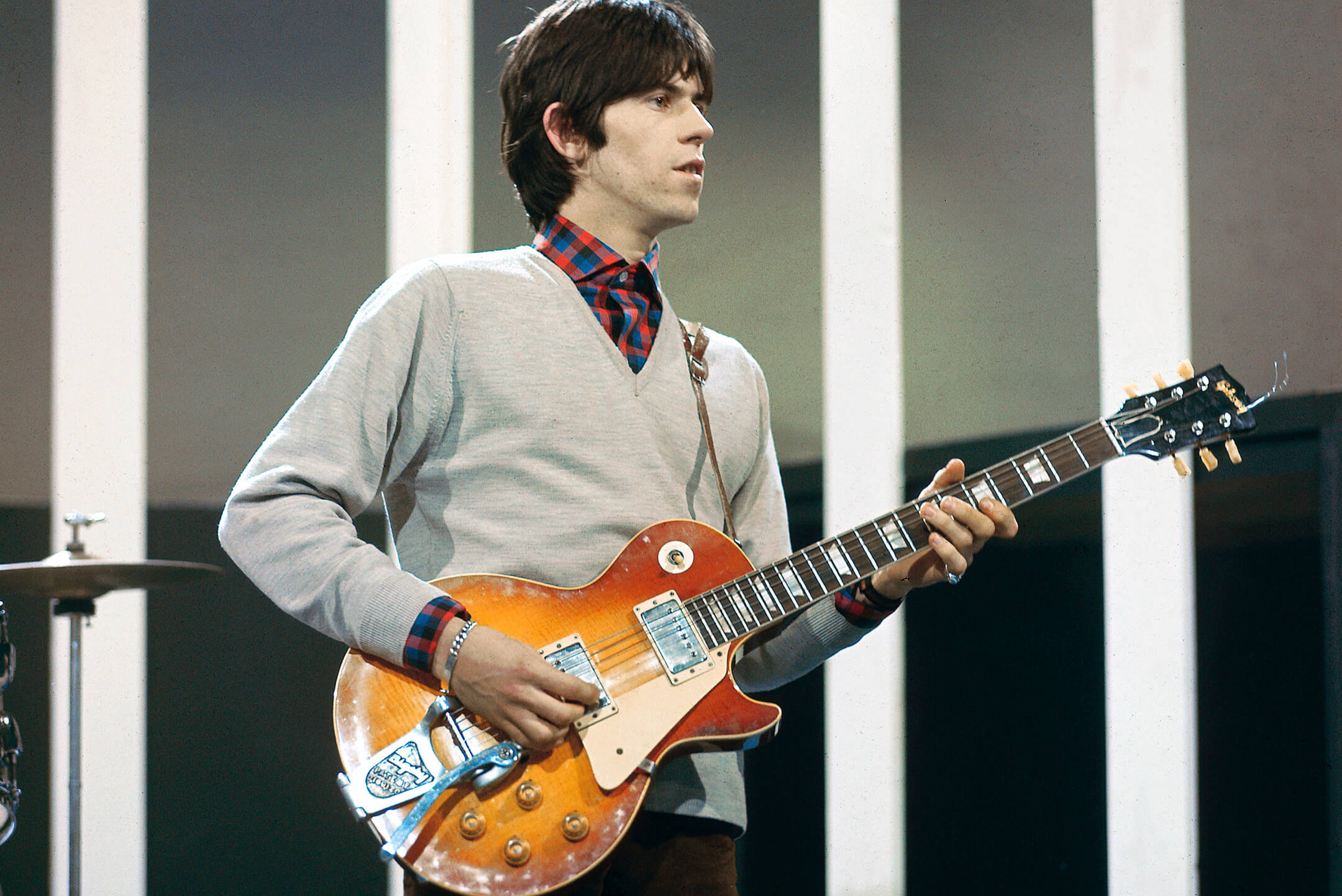
The Telecaster era
As Richards slid into his new style, he settled on new guitars as well. His most famous Fender Telecaster is nicknamed Micawber (after the David Copperfield character), and was supposedly a gift from Eric Clapton for Richards’ 27th birthday while the Stones were prepping to record Exile On Main Street at Nellcôte. It was a butterscotch finish blackguard 53, apparently with an Esquire neck. This was the era when Clapton was retooling and rebuilding Fenders as habit, so the story is plausible. Before long, Richards had made his own mods, installing a Gibson PAF humbucker at the neck position but with the magnet poles facing the tail end of the guitar. It also appeared to have a Fender pedal steel pickup fitted at the bridge. Learn how to retro-fit a humbucker in a Telecaster here.
Andy Babiuk told Guitar.com, “I’ve played hundreds of Fender Telecasters over the years. And then I got to play Micawber. I tell you: this guitar has a resonance, it really rings. That’s probably why Keith continues to go back to it. “If you look at the photos, where the neck joins the body, the fretboard is actually ‘scalloped’ on the bass side. Not by intention. It’s where Keith strums, and over the years he was just cutting away through the wood. That tells you how much Keith loves this guitar.”
“Of all the guitars, the Telecaster really lent itself well to a dry, rhythm, five-string drone thing,” Richards told Guitar World. “In a way that tuning kept me developing as a guitarist. ‘Okay, now figure out a diminished sixth on it!’ You’ve got so little to work with. And that makes you reconsider six-string concert tuning… you can swap knowledge between one tuning and another.”
Richards also own a more grainy finish 1994 Tele nicknamed Malcolm, which is set-up exactly like Micawber, except for the neck pickup being the “correct” way, and a 67 sunburst nicknamed Sonny (should really be ‘Sunny’, but there you go). All three are set up with 5-strings in open G tuning.
From the mid 70s, he also played a black Fender Telecaster Custom, originally with a full six strings.
There are many other guitars Keith nerds will know, such as his 1958 Gibson Les Paul TV Junior called Dice.
Andy Babiuk: “When Keith gets a guitar, it’s not because it’s new and shiny. When he got this, it had a sticker on it like you’d find on a car or something, a picture of dice. Keith likes naming his guitars, so it was always going to be Dice. It’s another guitar used on a lot on records and many live shows, too… but not for Tumbling Dice. His main use of it now is in regular tuning, but capo’d. It’s pretty much always played for Midnight Rambler.”
Other Gibsons include a black 1959 ES-355 mono (used live for Satisfaction), and a 1964 Gibson ES-345 Stereo (“da white one”, hence Dwight). Both are also in standard tuning.
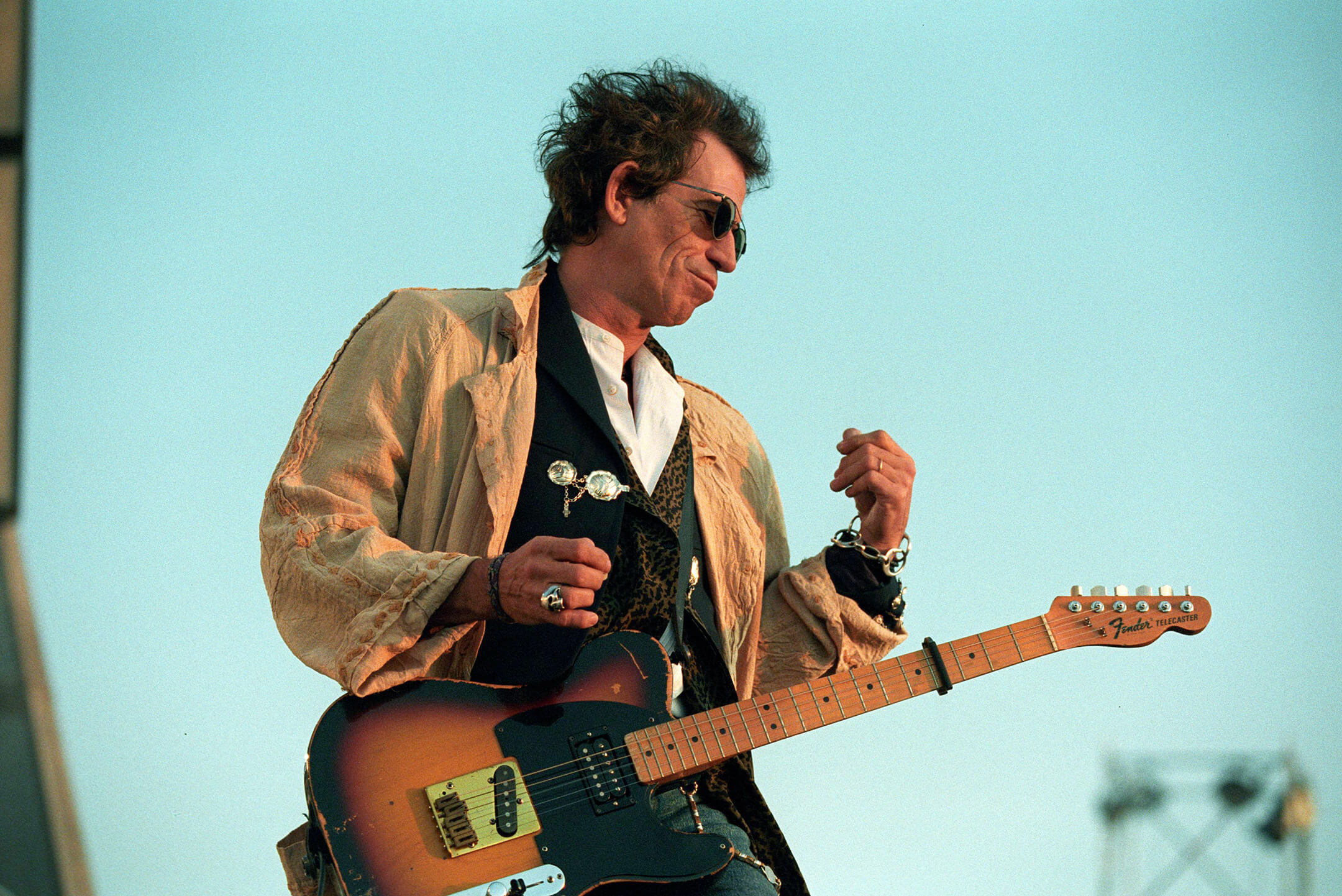
Keith Richards’ style
Does such a massive haul of different guitars mean you’ll get any closer to sounding like Richards? No! “People do separate them when they’re talking about music,” he says of his guitars, “but all of that often misses the whole point. There’s never a conscious effort to get that Honky Tonk Woman tone or a thing like that. You may get it or you may not. But that’s not what you’re thinking about. You’re thinking about the track.”
It’s the way he plays that is key. For later Stones tracks, good knowledge of chords in open tunings is crucial, but as for his uniquely loose phrasing, all we can do is wish you luck.
Essential tracks
There’s a glut of Stones compilations and live albums (usually played too fast) to choose from, but here’s a possibly futile attempt to distil the band’s back catalogue to just some tracks that highlight Richards’ unique way with a guitar… and his ability to wring hundreds of songs from the same notes.
